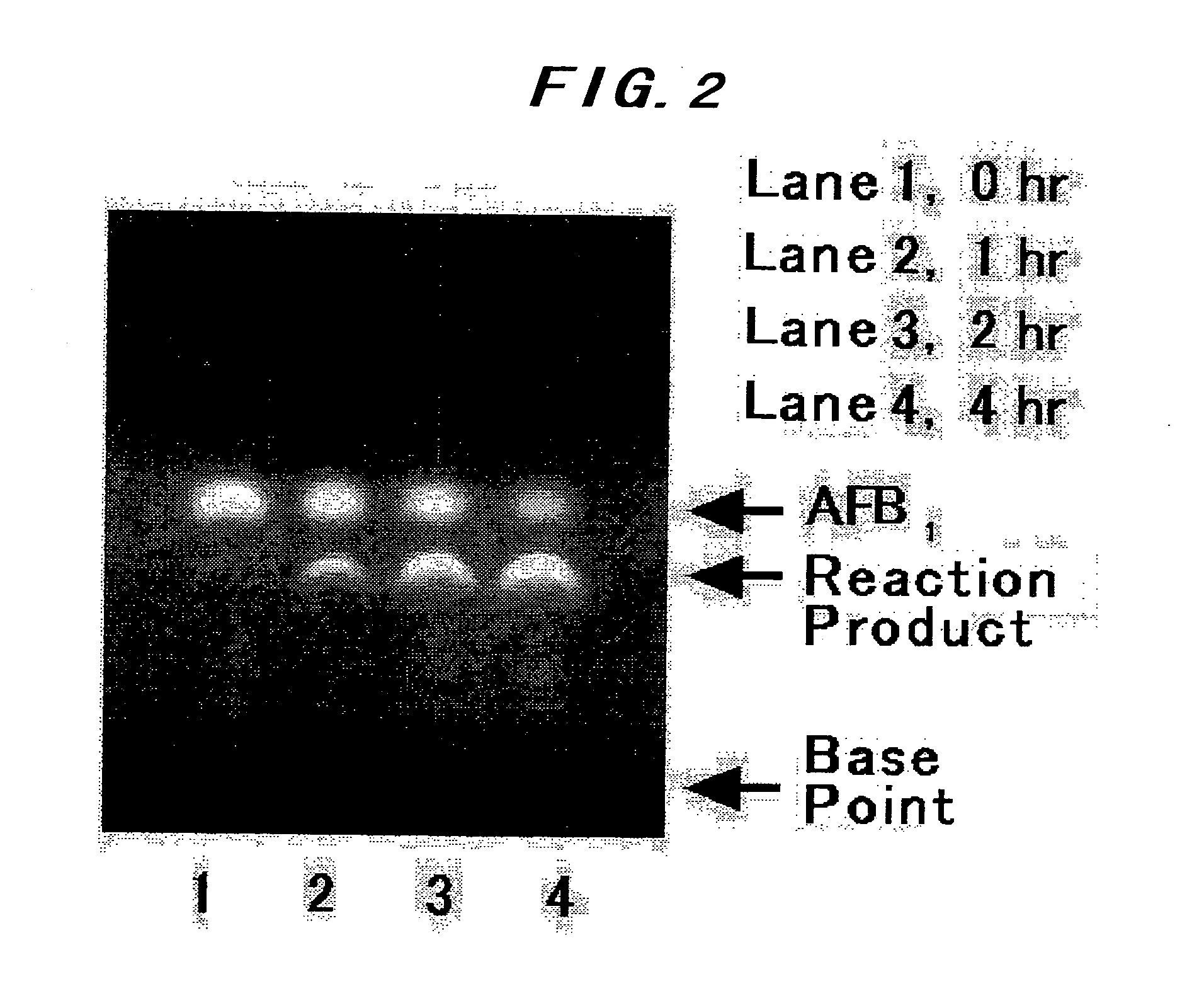Composition for degrading aflatoxins and other toxic substances
a technology of aflatoxins and toxic substances, applied in the field of aflatoxins and other toxic substances, can solve the problems of affecting the quality of aflatoxins, and affecting the quality of aflatoxins, and achieve the effect of efficient utilization
- Summary
- Abstract
- Description
- Claims
- Application Information
AI Technical Summary
Benefits of technology
Problems solved by technology
Method used
Image
Examples
example 1
Decomposition of AFB1 with Hemin:
[0053] Twenty five microliter of 200 mM phosphate buffer (pH 7.5), 10 μL of aqueous solution of 10% detergent (Tween 80), 38 μL of distilled water, 1 μL of 50 mM hydrogen peroxide aqueous solution, and 1 μL of DMSO aqueous solution of 1.6 mM AFB1 were put into a 0.5-mL microtube to prepare a reaction mixture. Here, 25 μL of 400 μM hemin suspension was added to it and incubated at 30° C. for 30 minutes. The final concentration of each component was: AFB1, 16 μM; hydrogen peroxide, 500 μM; Tween 80, 1%; hemin, 100 μM.
[0054] After the reaction, HPLC and TLC analyses were performed to confirm the degradation of AFB1 and the formation of reaction product. The equal amount of ethyl acetate was added to the reaction mixture, and extraction was done by mixing with a Voltex mixer for 1 minute. The resulting mixture was centrifuged at 10,000×g for 2 minutes, and the ethyl acetate layer (upper layer) was recovered in a new 0.5-mL microtube.
[0055] The extrac...
example 2
Effect of Hemin Amount Added on AFB1 Degradation:
[0065] AFB1 degradation was performed at 30° C. for 30 minutes in the same manner as in Example 1 except that the amount of hemin added was varied.
[0066] After the reaction, the amount of remaining AFB1 and that of AFQ1 formed were measured quantitatively by HPLC. The result is shown in FIG. 5.
[0067] As shown in FIG. 5, higher AFB1 degradation was observed with a larger amount of hemin addition. When 200 μM of hemin was added, approximately 25% of AFB1 was degraded through reaction at 30° C. for 30 minutes.
example 3
Effect of Hydrogen Peroxide Amount Added on AFB1 Degradation with Hemin:
[0068] AFB1 degradation was performed at 30° C. for 30 minutes in the same manner as in Example 1 except that the amount of hydrogen peroxide added was varied.
[0069] After the reaction, amount of the remaining AFB1 and that of AFQ1 formed were measured quantitatively by HPLC. The result is shown in FIG. 6.
[0070] As shown in FIG. 6, addition of hydrogen peroxide at the concentration from 0.1 to 1.0 mM showed more significant effect for the promotion of AFB1-degradation than no addition of hydrogen peroxide, and the AFB1-degradation efficiency was high (20 to 23%) Though not shown, when hydrogen peroxide was added at the concentration from 1.0 mM to 10 mM, no significant increase was observed in AFB1-degradation efficiency depending on hydrogen peroxide concentration.
PUM
| Property | Measurement | Unit |
|---|---|---|
| temperature | aaaaa | aaaaa |
| temperature | aaaaa | aaaaa |
| pH | aaaaa | aaaaa |
Abstract
Description
Claims
Application Information
 Login to View More
Login to View More - R&D
- Intellectual Property
- Life Sciences
- Materials
- Tech Scout
- Unparalleled Data Quality
- Higher Quality Content
- 60% Fewer Hallucinations
Browse by: Latest US Patents, China's latest patents, Technical Efficacy Thesaurus, Application Domain, Technology Topic, Popular Technical Reports.
© 2025 PatSnap. All rights reserved.Legal|Privacy policy|Modern Slavery Act Transparency Statement|Sitemap|About US| Contact US: help@patsnap.com



